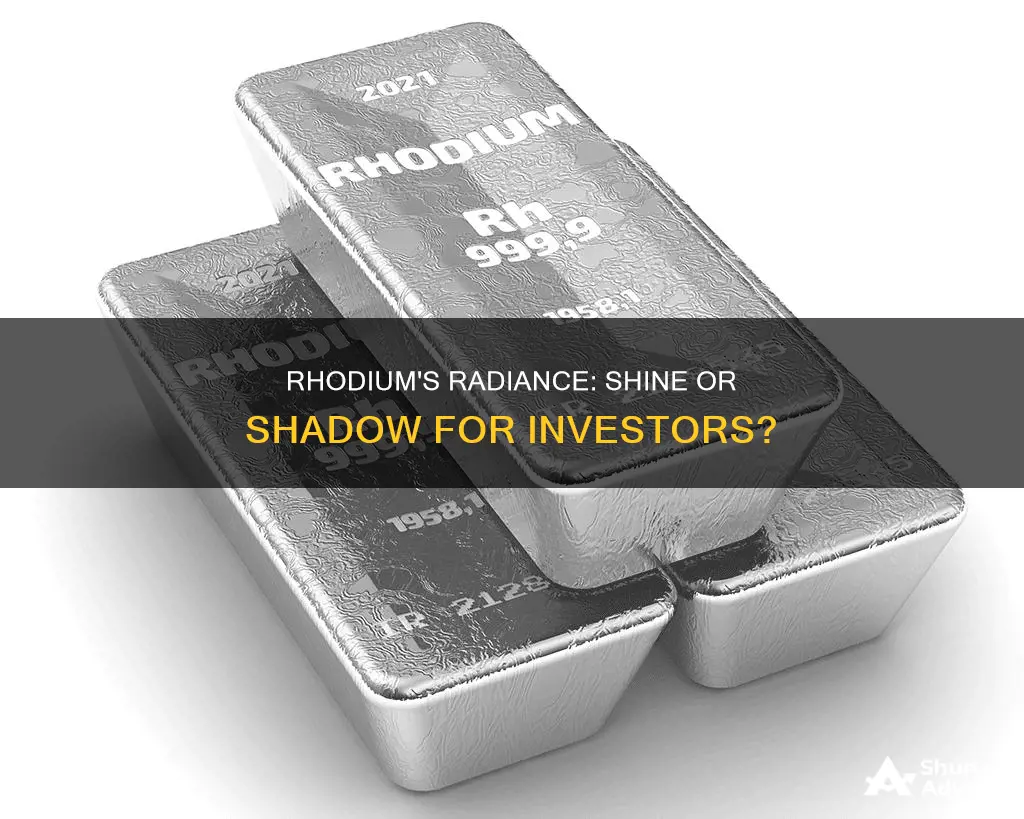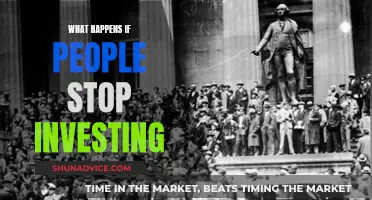
Rhodium is a rare, lustrous, silvery-white metal that has become an increasingly valuable investment option. Its rarity, with only 28 tons mined annually, and its high demand from the automotive industry for use in catalytic converters, have driven up its price. In recent years, rhodium has seen significant price surges, with a 3000% increase in five years as of early 2021. However, investing in rhodium comes with risks due to its high volatility and the small, illiquid market, which can lead to sharp price swings. As such, it is generally recommended for experienced investors.
| Characteristics | Values |
|---|---|
| Rarity | Rhodium is rarer than gold, silver, platinum, and palladium |
| Corrosion resistance | Rhodium is corrosion-resistant |
| Electrical conductivity | Rhodium is used in electrical contacts |
| Reflectivity | Rhodium has very high reflective properties |
| Hardness | Rhodium is a hard metal |
| Density | Rhodium is a dense metal |
| Volatility | Rhodium's price is volatile |
| Industrial use | Rhodium is used in catalytic converters and as a coating agent |
| Investment product availability | Investment products include coins, bars, ETFs, and cryptocurrencies |
| Sources of supply | Rhodium is primarily extracted from mines in South Africa |
What You'll Learn

Rhodium's rarity
Rhodium is an extremely rare metal. It is one of the rarest and most valuable precious metals on Earth. It is also one of the rarest elements in the Earth's crust, comprising an estimated 0.0002 parts per million.
Rhodium is a hard, silvery-white, corrosion-resistant transition metal. It is a member of the platinum group of metals, which are considered noble metals. It is mined as a byproduct of platinum mining, with only 28 tons of rhodium mined annually, compared to 220 tons of platinum. South Africa is the largest producer of rhodium, accounting for approximately 80% of the world's rhodium supply in 2010. Other sources of rhodium include the river sands of the Ural Mountains in Russia, North and South America, and the copper-nickel sulfide ores in Ontario, Canada.
The rarity of rhodium affects its price and commercial applications. It is used in a variety of industries, including automotive, jewelry, chemical, and electrical. About 80% of rhodium is used in catalytic converters in cars to clean exhaust emissions, particularly to break down harmful nitrous oxide molecules. Rhodium is also used in the chemical industry as a catalyst for making nitric acid, acetic acid, and hydrogen reactions. In the electrical industry, rhodium is used as a coating for optic fibers and optical mirrors due to its corrosion resistance and electrical conductivity.
The price of rhodium has been volatile, with significant fluctuations over the years. Its rarity and the large global demand, particularly from the automotive industry, have driven up the price of rhodium significantly.
The Mystery of Investment Returns: Unveiling the 'When' in Profitable Ventures
You may want to see also

The metal's volatility
The Metals Volatility
Rhodium is a lustrous, silvery-white metal that is hard, dense, and corrosion-resistant. It is a precious metal that is far rarer than gold, silver, platinum, and palladium. However, it has rarely been considered an investment metal due to its volatile pricing and the lack of investment products available.
The price of rhodium has been extremely volatile, making it a risky investment. Between 2004 and 2008, rhodium prices rose by a staggering 2,112%, from $452 per ounce to $10,000 per ounce, only to plummet back below $1,000 per ounce in less than a year. From 2012 to 2016, prices fluctuated between $1,800 and $600 per ounce, and in 2017-2018, they rose almost 150% to $2,500 per ounce. This volatility is due in part to the small market size and the difficulty in increasing production.
The rhodium market is highly dependent on the automotive industry, which accounts for about 80% of rhodium demand. In recent years, rhodium prices have been influenced by automotive manufacturers' recalls of vehicles to replace catalytic converters to meet emissions standards. For example, in early 2019, Toyota recalled 862,520 vehicles, leading to a 17% price jump for rhodium.
Additionally, the majority of the world's rhodium supply (80%) comes from South Africa, making the metal's pricing vulnerable to geopolitical risks in the region. This concentration of supply also means that prices can skyrocket when demand increases, as there is little ability to increase production.
While rhodium's rarity and industrial applications make it an attractive investment, the market's volatility and small size can make it challenging to exit investments profitably. As such, rhodium is generally recommended for experienced investors.
Apple: A Popular Investment Choice
You may want to see also

Its use in catalytic converters
Rhodium's application in catalytic converters is a significant factor in its investment potential. Introduced in the mid-1970s, catalytic converters employ rhodium to reduce pollutants in automobile exhaust emissions, thereby minimising the environmental impact of cars. This use of rhodium is crucial in meeting stringent emission norms and maintaining clean air.
The average quantity of rhodium in a catalytic converter is about 1-2 grams, and the average weight of a catalytic converter is approximately 1.2 kg or 2.2 pounds. The amount of rhodium in a catalytic converter can vary depending on the car's make, model, and engine. Some vehicles with the same engine may have different converters depending on the country.
The role of rhodium in catalytic converters is to work alongside other elements such as palladium to cleanse toxins from exhaust fumes before they are released into the environment. Rhodium is particularly effective in this process due to its high resistance to corrosion and its ability to withstand high temperatures and acids.
The demand for rhodium in catalytic converters has contributed to its high cost, with prices reaching approximately $290 per gram. The recycling of old catalytic converters is a viable source of rhodium, as it can be easily recovered from the honeycomb part of the converter without losing its properties.
The automotive industry's need for rhodium in catalytic converters has been a significant driver of the metal's price surge. As car manufacturers strive to meet stricter emission regulations, the demand for rhodium is expected to remain high, influencing its potential as an investment option.
Fidelity Investments 1099-R: When Can I Expect Mine?
You may want to see also

The rhodium market's small size
The rhodium market is small compared to other precious metals. Only 28 tons of rhodium are mined annually, compared to 220 tons of platinum and over 2,300 tons of gold. This makes rhodium more than 100 times rarer than gold.
The small size of the rhodium market is due to the limited number of mines that can produce it. There are fewer than a dozen mines globally that can extract rhodium, which is always extracted as a byproduct of platinum mining. 80% of the world's rhodium comes from South Africa, with smaller amounts coming from Russia and Canada.
The rhodium market is also small in terms of its value. In 2022, the global rhodium market was valued at USD 2.22 billion. In comparison, the gold market was valued at around USD 370 billion in 2022.
Despite its small size, the rhodium market has been growing. The market size is expected to reach USD 3.66 billion by 2031, exhibiting a compound annual growth rate (CAGR) of 5.70% from 2024 to 2031. The rising demand for catalytic converters in the automotive industry, the growing demand for electric vehicles, and the unique catalytic properties of rhodium are driving the market's growth.
The small size of the rhodium market has implications for its investment potential. The limited supply and fluctuating demand for rhodium can lead to significant price volatility. Small changes in market conditions can cause substantial price swings. For example, from 2004 to 2008, the price of rhodium rose 2,112% from $452 per ounce to $10,000 per ounce, only to fall back below $1,000 per ounce in less than a year.
Therefore, while rhodium's rarity and industrial applications make it an attractive investment option, the small size of the market and the resulting price volatility are important considerations for potential investors.
The Future is Now: Embracing Innovation Through Investments
You may want to see also

Ways to invest in rhodium
Rhodium is a lustrous white metal that is hard, dense, and highly reflective. It is also an excellent conductor of heat and electricity. In the past, rhodium was not considered an investment option like other precious metals such as gold, silver, platinum, and palladium. However, due to its rarity and increasing demand from the automotive industry, rhodium has become an attractive investment prospect. Here are some ways to invest in rhodium:
Physical Investment in Rhodium Bullion Bars and Coins:
The best way to buy physical rhodium is in the form of bullion bars. Rhodium bars are typically made of 99.9% fine rhodium and are available from mints such as Baird & Co., PAMP Suisse, and Cohen Mint. Baird & Co. offers the world's first legal tender rhodium coin, the Tuvaluan $100 Coin, which is extremely rare and valuable. However, rhodium coins have limited availability in the bullion markets, making bars the most accessible option.
Exchange-Traded Products:
If you prefer not to buy physical rhodium, there are exchange-traded products available, such as the Xtrackers Physical Rhodium ETF XFRD and AfricaRhodium ETF ETFRHO. These products provide exposure to rhodium without the need to purchase and store the physical metal.
Diversification with Other Precious Metals:
Investors can also consider diversifying their portfolios by combining rhodium with other precious metals like gold, silver, platinum, and palladium. This strategy can provide a more comprehensive overview of the precious metals market and potentially mitigate some of the risks associated with investing in a single metal.
Industrial and Commercial Applications:
Rhodium is used in various industrial and commercial applications due to its unique properties. It is often used as a coating agent to improve the corrosion resistance of other metals, in jewellery to enhance scratch resistance and lustre, and in high-quality glass and LCD screen production. Investing in companies or industries that utilise rhodium in their manufacturing processes can provide indirect exposure to the metal's performance.
When considering investing in rhodium, it is important to remember that it is a volatile and expensive asset class. It is generally recommended for experienced investors who understand the potential risks and rewards. Additionally, ensure that you acquire rhodium products from trusted vendors to avoid any issues with authenticity or security.
Maximizing an Inheritance: Strategies for Investing Toward Retirement
You may want to see also
Frequently asked questions
Rhodium is a lustrous, silvery-white metal that is hard and dense. It is used in catalytic converters and as a coating on jewellery to improve scratch resistance and shine.
Rhodium is a rare precious metal that has become increasingly valuable due to high demand from the automotive industry. It is also used in high-quality glass and LCD screen production. Its rarity and industrial applications make it an attractive investment option for diversifying portfolios.
The best way to invest in rhodium is by purchasing physical bullion in the form of coins and bars. The Tuvaluan $100 coin is the world's first legal tender made of rhodium, making it a valuable investment and collectible item. Rhodium bars, such as those offered by Baird & Co. and PAMP Suisse, are also a good option as they are easy to store and ship.
Rhodium is recommended for experienced investors as it is expensive and volatile. The market for rhodium is small and illiquid, and its value is tied to geopolitical stability in South Africa, where most of the world's rhodium is sourced. Additionally, the high melting point and hardness of rhodium make minting coins challenging, resulting in fractures during the stamping process.







